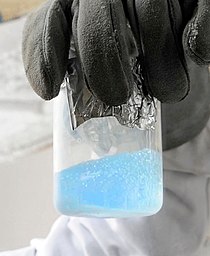
|
 Liquid oxygen boiling | |||||||||||||||||||||
| General properties | |||||||||||||||||||||
|---|---|---|---|---|---|---|---|---|---|---|---|---|---|---|---|---|---|---|---|---|---|
| Allotropes | O2, O3 (ozone) | ||||||||||||||||||||
| Appearance | (O2) gas: colourless liquid and solid: pale blue | ||||||||||||||||||||
| Standard atomic weight (Ar, standard) | [15.99903, 15.99977] | ||||||||||||||||||||
| Abundance | |||||||||||||||||||||
| in the Earth's crust | 46% | ||||||||||||||||||||
| in the oceans | 86% | ||||||||||||||||||||
| in the solar system | 1% | ||||||||||||||||||||
| Oxygen in the periodic table | |||||||||||||||||||||
| |||||||||||||||||||||
| Atomic number (Z) | 8 | ||||||||||||||||||||
| Group | group 16 (chalcogens) | ||||||||||||||||||||
| Period | period 2 | ||||||||||||||||||||
| Block | p-block | ||||||||||||||||||||
| Electron configuration | [He] 2s2 2p4 | ||||||||||||||||||||
Electrons per shell | 2, 6 | ||||||||||||||||||||
| Physical properties | |||||||||||||||||||||
| Phase at STP | O: Gas (O2) | ||||||||||||||||||||
| Melting point | 54.36 K (−218.79 °C, −361.82 °F) | ||||||||||||||||||||
| Boiling point | 90.188 K (−182.962 °C, −297.332 °F) | ||||||||||||||||||||
| Density (at STP) | 1.429 g/L | ||||||||||||||||||||
| when liquid (at b.p.) | 1.141 g/cm3 | ||||||||||||||||||||
| Triple point | 54.361 K, 0.1463 kPa | ||||||||||||||||||||
| Critical point | 154.581 K, 5.043 MPa | ||||||||||||||||||||
| Heat of fusion | (O2) 0.444 kJ/mol | ||||||||||||||||||||
| Heat of vaporization | (O2) 6.82 kJ/mol | ||||||||||||||||||||
| Molar heat capacity | (O2) 29.378 J/(mol·K) | ||||||||||||||||||||
Vapor pressure
| |||||||||||||||||||||
| Atomic properties | |||||||||||||||||||||
| Oxidation states | −1, −2, +1, +2 | ||||||||||||||||||||
| Electronegativity | Pauling scale: 3.44 | ||||||||||||||||||||
| Ionization energies |
| ||||||||||||||||||||
| Covalent radius | 66±2 pm | ||||||||||||||||||||
| Van der Waals radius | 152 pm | ||||||||||||||||||||
| Spectral lines of oxygen | |||||||||||||||||||||
| Other properties | |||||||||||||||||||||
| Natural occurrence | O: Primordial | ||||||||||||||||||||
| Crystal structure | cubic | ||||||||||||||||||||
| Speed of sound | 330 m/s (gas, at 27 °C) | ||||||||||||||||||||
| Thermal conductivity | 26.58×10−3 W/(m·K) | ||||||||||||||||||||
| Magnetic ordering | paramagnetic | ||||||||||||||||||||
| Magnetic susceptibility | +3449.0·10−6 cm3/mol (293 K) | ||||||||||||||||||||
| CAS Number | 7782-44-7 | ||||||||||||||||||||
| History | |||||||||||||||||||||
| Discovery | Carl Wilhelm Scheele (1771) | ||||||||||||||||||||
| Named by | Antoine Lavoisier (1777) | ||||||||||||||||||||
| Main isotopes of oxygen | |||||||||||||||||||||
| |||||||||||||||||||||
Oxygen is a chemical element. It has the symbol O and atomic number 8. It is the third most common element in the universe, after hydrogen and helium.
Oxygen is more than a fifth of the Earth's atmosphere by volume. In the air, two oxygen atoms usually join to make dioxygen (O2), a colourless gas. This gas is often just called oxygen. It has no taste or smell. It is pale blue when it is liquid or solid.